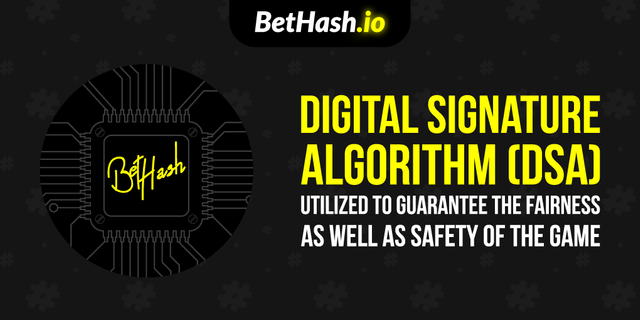BetHash.io: Digital Signature Algorithm (#DSA) utilized to ensure the both the fairness and the safety of the gaming results
Fairness
Satoshi-Style: The Outcome is not Controlled by the House
Just like the famous [Satoshi Dice], who uses Bitcoin transaction hash to generate winning numbers, all winning numbers of BetHash.io games are generated based on the latest EOS transaction hash, a sequence of numbers and letters produced by the 21 EOS block producers.
To prevent Hackers from maliciously attacking the EOS mainnet to control the hash value of the EOS blocks, BetHash.io utilize the Digital Signature Algorithm (DSA) to guarantee the fairness as well as safety of the game.
Signed Hash = SHA256(SIGN(Private Key, Original EOS Block Hash))
Every gaming results can be verified that it has been signed by the specific private key using our release public key below.
Public Key:
Unlike other platforms that generate outcomes using a random number generator on their own server, potentially opening opportunities for the platform to modify the results and cheat players, BetHash.io cannot interfere with the results, as the generation of EOS transaction hash IDs is completely out of our control, and the signature of our private key can be verified by our published private key.
Why Use the Blockchain Transaction Hash?
Since the EOSHASH lottery runs every minute, only the EOS transaction hash is generated regularly enough to be used to determine the winning numbers. EOS has a 0.5 second block time, which means 2 blocks are generated every second, with each of these blocks having a randomly generated transaction hash.
Compared to Bitcoin (10 minutes) and Ethereum (2.5 minutes), EOS has the fastest block generation time making it best suitable for our fast-paced lottery game! Soon, EOSHASH will be releasing games that refer to the Bitcoin or Ethereum hash, allowing everybody to participate whatever their favorite blockchain!
The Digital Signature Algorithm (DSA) that underlies the Blockchain World
The DSA algorithm uses a key pair consisting of a public key and a private key. The private key is used to generate a digital signature for a message, and such a signature can be verified by using the signer's corresponding public key.
The digital signature provides message authentication (the receiver can verify the origin of the message), integrity (the receiver can verify that the message has not been modified since it was signed) and non-repudiation (the sender cannot falsely claim that they have not signed the message).
To know more about DSA, check it out here on Wikipedia: https://en.wikipedia.org/wiki/Digital_Signature_Algorithm
What to Become an EOS Guru?
We get it, all this talk about EOS transaction IDs can be confusing. Because of this, we recommend checking out the official EOSIO GitHub page to learn more about how generates completely randomly transaction IDs and how the EOS blockchain is arguably the most secure blockchain currently available.
Check it out here: https://github.com/EOSIO/eos
